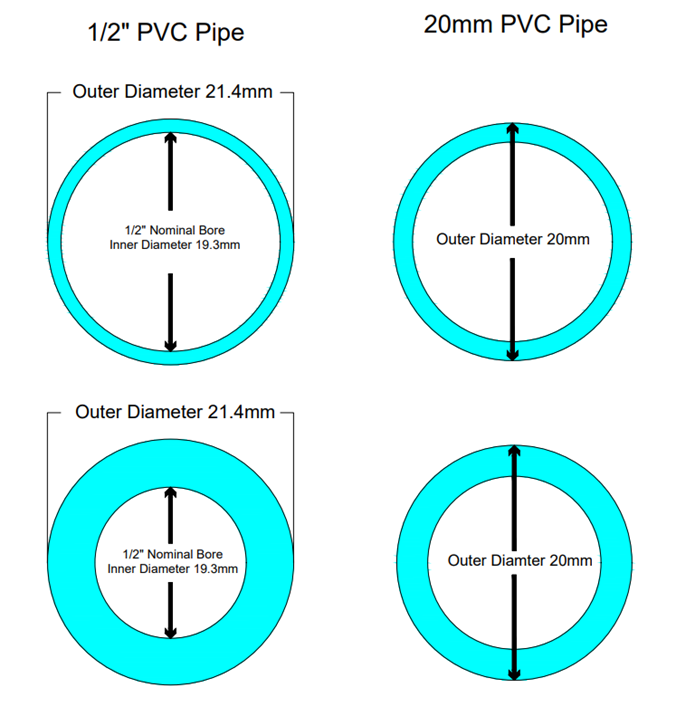They
are used to join PVC pipes together to form a complete piping system. PVC
fittings come in two different measurement systems: imperial and metric. Understanding the differences between imperial and metric
PVC fittings is essential to choose the right fittings for your piping system.
In this blog, we will explore the differences between imperial and metric PVC
fittings and their applications.
Imperial
PVC Fittings
Imperial PVC fittings are manufactured in inches and are
widely used in North America, the United Kingdom, and other countries that use
the imperial system of measurements. The imperial measurement system has been
in use for hundreds of years and is based on feet, inches, and fractions of
inches.
Imperial PVC fittings are usually manufactured in standard
sizes ranging from 1/2 inch to 10 inches in diameter. The outside diameter of
imperial PVC fittings matches the nominal size of the pipe, and These fittings
typically have a slightly thicker wall and a higher pressure rating compared to
metric fittings.
Imperial PVC fittings are known for their durability and
chemical resistance. They are commonly used in a wide range of applications,
including water supply, wastewater treatment, and chemical processing.
Metric
PVC Fittings
Metric PVC fittings are manufactured in millimeters and are
widely used in Europe, Asia, and other countries that use the metric system of
measurements. The metric measurement system is based on meters, centimeters,
and millimeters and has been in use for over 200 years.
Metric PVC fittings are manufactured in standard sizes
ranging from 16 mm to 250 mm in diameter. The outside diameter of metric PVC
fittings matches the nominal size of the pipe, and These fittings typically
have a lower pressure rating but have a thinner wall, making them lighter and
easier to handle.
Metric PVC fittings are known for their durability and
chemical resistance, similar to imperial PVC fittings. They are commonly used
in a wide range of applications, including water supply, wastewater treatment,
and chemical processing.
Differences
between Imperial and Metric PVC Fittings
There are several differences between imperial and metric
PVC fittings, including measurement system, size, and compatibility.
Measurement
System
The most obvious difference between imperial and metric PVC fittings is the measurement system used to manufacture them. Imperial PVC fittings are manufactured in inches, while metric PVC fittings are manufactured in millimeters.
Size
The size of imperial PVC fittings ranges from 1/2 inch to 10
inches in diameter, while metric PVC fittings range from 16 mm to 250 mm in
diameter. This difference in size range means that metric PVC fittings are
typically smaller in size than imperial PVC fittings.
Compatibility
Imperial PVC fittings are not compatible with metric PVC
pipes, and vice versa. This means that imperial PVC fittings can only be used
with imperial PVC pipes, and metric PVC fittings can only be used with metric
PVC pipes.

Fig.1: Difference in the dimension of Imperial and Metric pipe
Choosing
the Right PVC Fittings
The choice between imperial and metric PVC fittings depends
on the piping system you are using. If you are using imperial PVC pipes, you
should use imperial PVC fittings, and if you are using metric PVC pipes, you
should use metric PVC fittings.
It is also important to consider the size of the fittings
you need. PVC fittings are manufactured in standard sizes, so it is essential
to choose the right size for your piping system. You should also consider the
type of application the fittings will be used for and choose fittings that are
appropriate for that application.
Is there any chance to match imperial fittings to
the metric pipe and vice versa?
It is not possible to directly match an imperial fitting to the
metric pipe as they are different measurement systems and have different
dimensional specifications. You would need an adapter to connect the two, which
can be obtained from plumbing supply stores. However, it is important to note
that the compatibility and suitability of the adapter depend on the specific
application and conditions, and it is advisable to consult a professional
plumber or engineer to ensure a safe and secure connection.
.png)
No comments yet. Start a new discussion.